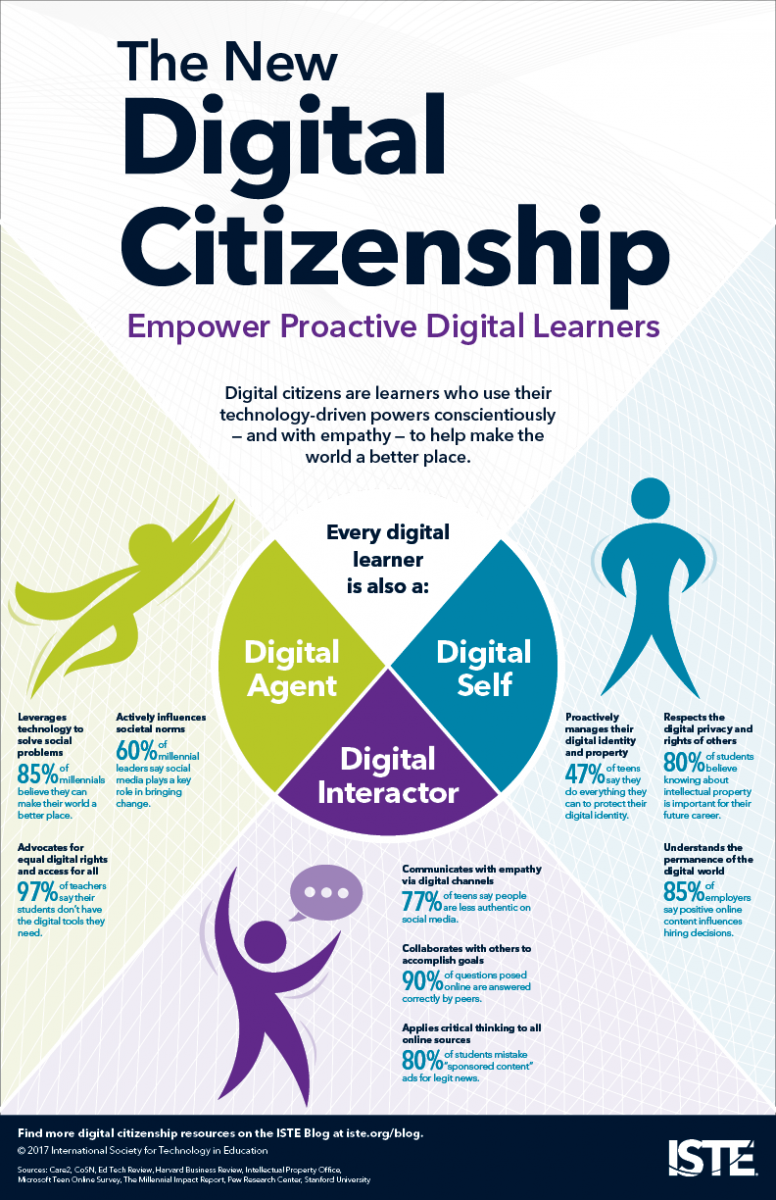Combining digital citizenship with confidence-boosting activities helps students build associative pathways that link a positive self-image with digital citizenship and netiquette. Furthermore, since your students are undoubtedly on social media, consider the best practices for modeling positive interaction on the medium. Digital citizenship is appropriate, responsible behavior when using technology. This includes social media, websites, online forums, communities, comments, and in apps and other device features. Teaching children and teens digital citizenship skills can help to prevent cyberbullying and its negative effects.
Digital citizenship is appropriate, responsible behavior when using technology. This includes social media, websites, online forums, communities, comments, and in apps and other device features. Teaching children and teens digital citizenship skills can help to prevent cyberbullying and its negative effects. When children learn positive online behaviors, social media can be used in productive ways.
Teenagers are often the first to use new social media and digital technology. Research shows that 95% of American youth aged 12‐17 use the internet.1 Among U.S. teens that use social media, 88% witness mean or cruel behavior, 67% observe others joining in those negative behaviors, and 21% admit to joining in at least once in a while.1 Parents are the first source of advice teens go to about responsible internet use. And parents can monitor what their children do online in a variety of ways. Teachers are the second source of information for teens.1 Both parents and teachers play an important role in teaching digital citizenship skills, including digital safety and digital etiquette.2
Digital Safety
Digital safety involves identifying and taking measures to protect against potential risks when using devices, apps, and the internet. Sharing personal information online can put children and teens at risk for the misuse of personal data, cyberbullying, and exposure to harmful content that may contain violence, suicide, and racist and adult material. Teens may not want or intend to access or post inappropriate content online. However, 44% admitted to giving a false age to access a website or sign up for an online account.1 Parental knowledge and involvement in mediating teenagers’ online activities influence whether teens behave appropriately and responsibly when using digital technologies.3
To reduce risks, parents can help their children set the privacy controls on their devices and accounts to ensure their children’s content is not shared with the public. Parents should proactively discuss the types of content and information that is safe or acceptable to share, post, and view online. It is important to foster open dialogue in which youth feel comfortable sharing their cyber experiences with caregivers and other supportive adults. Other tactics parents can use to ensure their children’s online safety include:

- Following their child’s social media accounts.4
- Checking the websites that their child visited.4
- Knowing the passwords to their child’s email, social media accounts, and cell phones.4
- Searching online for information available about their child.1
Digital Etiquette
Digital etiquette refers to an individual’s conduct online and in their use of technology. The virtual nature of social media and the privacy of using individual devices can embolden some to say or do things in cyberspace that they would not do in person. Appropriate behavior for digital interactions should follow the same social guidelines as face‐to‐face interactions.5 Digital etiquette also extends to conduct beyond the screen – how and when individuals use their devices around others in different social settings.5 Teaching good digital etiquette skills involves:
- Talking about what to do when children or teens witness cyberbullying or hurtful content.4
- Discussing appropriate content children or teens can share, view, or access online.4
- Reviewing appropriate behavior toward others online4 so that online interactions follow the same social guidelines as face‐to‐face interactions.5
- Role modeling and discussing respectful and tolerant behavior of others; including not posting hurtful, mean, vengeful, or disrespectful content.4
- Role modeling appropriate device use including the amount of time spent on devices, and use of devices around others.5
- Discussing places that should be device‐free, like bathrooms and locker rooms.
- Talking about the permanency of content posted online, and how this can affect online reputation and can have negative consequences with college and job applications.
- Setting limits at every age for use of devices.5
Adults should teach digital citizenship skills to reinforce to children and teens that when they are using their voices online they must choose their words wisely and speak with respect and compassion. Most of these strategies should be used, discussed, and updated on an ongoing basis to address the changing social needs of children and teens as they get older, and with the emergence of new technologies. By being a role model for good digital citizenship and providing ongoing guidance on digital safety and etiquette, parents, teachers, and other caregivers can help prevent harmful behavior from happening, including cyberbullying.
Source and Research Limitations
This report includes the most up to date research on bullying, but it is important to note that this research has several important imitations. Most of the research is cross sectional, which means it took place at one point in time. This type of research shows us what things are related to each other at that time, but cannot tell us which thing came first or if one of those things caused the other to occur.
Another limitation is that many of the studies use self reports to identify who bullied or was bullied and to capture symptoms or experiences. While the use of self report is common in bullying research, it can result in biases or errors. The study participants must report information accurately, and some children may not want to admit to others that they have been bullied or have bullied others.
- 1.a.b.c.d. Lenhart, A., Madden, M., Rainie, L., Smith, A., Purcell, K., Zickuhr, K. (2011) Teens, Kindness, and Cruelty on Social Network Sites, Pew Research Center.
- 2. Jones, L., Mitchell, K. (2016). 'Defining and Measuring Youth Digital Citizenship.' New Media & Society 2016, Vol. 18(9) 2063–2079. doi: 10.1177/1461444815577797.
- 3. Wang, X., & Xing, W. (2018). 'Exploring the Influence of Parental Involvement and Socioeconomic Status on Teen Digital Citizenship: A Path Modeling Approach.' Journal of Educational Technology & Society, 21(1), 186–199.
- 4.a.b.c.d.e.f.g. Anderson, M. (2016). Parents, Teens and Digital Monitoring, Pew Research Center.
- 5.a.b.c.d.e. Brown, A., Flinn, S., Hill, D., Jana, L., Shifrin, D. (2015). American Academy of Pediatrics, 'Growing Up Digital: Media Research Symposium.'
Digital citizenship is appropriate, responsible behavior when using technology. This includes social media, websites, online forums, communities, comments, and in apps and other device features. Teaching children and teens digital citizenship skills can help to prevent cyberbullying and its negative effects. When children learn positive online behaviors, social media can be used in productive ways.
Teenagers are often the first to use new social media and digital technology. Research shows that 95% of American youth aged 12‐17 use the internet.1 Among U.S. teens that use social media, 88% witness mean or cruel behavior, 67% observe others joining in those negative behaviors, and 21% admit to joining in at least once in a while.1 Parents are the first source of advice teens go to about responsible internet use. And parents can monitor what their children do online in a variety of ways. Teachers are the second source of information for teens.1 Both parents and teachers play an important role in teaching digital citizenship skills, including digital safety and digital etiquette.2
Digital Citizenship Common Sense Media
Digital Safety

Digital safety involves identifying and taking measures to protect against potential risks when using devices, apps, and the internet. Sharing personal information online can put children and teens at risk for the misuse of personal data, cyberbullying, and exposure to harmful content that may contain violence, suicide, and racist and adult material. Teens may not want or intend to access or post inappropriate content online. However, 44% admitted to giving a false age to access a website or sign up for an online account.1 Parental knowledge and involvement in mediating teenagers’ online activities influence whether teens behave appropriately and responsibly when using digital technologies.3
To reduce risks, parents can help their children set the privacy controls on their devices and accounts to ensure their children’s content is not shared with the public. Parents should proactively discuss the types of content and information that is safe or acceptable to share, post, and view online. It is important to foster open dialogue in which youth feel comfortable sharing their cyber experiences with caregivers and other supportive adults. Other tactics parents can use to ensure their children’s online safety include:
- Following their child’s social media accounts.4
- Checking the websites that their child visited.4
- Knowing the passwords to their child’s email, social media accounts, and cell phones.4
- Searching online for information available about their child.1
Digital Etiquette
Digital etiquette refers to an individual’s conduct online and in their use of technology. The virtual nature of social media and the privacy of using individual devices can embolden some to say or do things in cyberspace that they would not do in person. Appropriate behavior for digital interactions should follow the same social guidelines as face‐to‐face interactions.5 Digital etiquette also extends to conduct beyond the screen – how and when individuals use their devices around others in different social settings.5 Teaching good digital etiquette skills involves:
- Talking about what to do when children or teens witness cyberbullying or hurtful content.4
- Discussing appropriate content children or teens can share, view, or access online.4
- Reviewing appropriate behavior toward others online4 so that online interactions follow the same social guidelines as face‐to‐face interactions.5
- Role modeling and discussing respectful and tolerant behavior of others; including not posting hurtful, mean, vengeful, or disrespectful content.4
- Role modeling appropriate device use including the amount of time spent on devices, and use of devices around others.5
- Discussing places that should be device‐free, like bathrooms and locker rooms.
- Talking about the permanency of content posted online, and how this can affect online reputation and can have negative consequences with college and job applications.
- Setting limits at every age for use of devices.5
Adults should teach digital citizenship skills to reinforce to children and teens that when they are using their voices online they must choose their words wisely and speak with respect and compassion. Most of these strategies should be used, discussed, and updated on an ongoing basis to address the changing social needs of children and teens as they get older, and with the emergence of new technologies. By being a role model for good digital citizenship and providing ongoing guidance on digital safety and etiquette, parents, teachers, and other caregivers can help prevent harmful behavior from happening, including cyberbullying.

Digital Citizenship Images
Source and Research Limitations
Digital Citizenship Poster
This report includes the most up to date research on bullying, but it is important to note that this research has several important imitations. Most of the research is cross sectional, which means it took place at one point in time. This type of research shows us what things are related to each other at that time, but cannot tell us which thing came first or if one of those things caused the other to occur.
Another limitation is that many of the studies use self reports to identify who bullied or was bullied and to capture symptoms or experiences. While the use of self report is common in bullying research, it can result in biases or errors. The study participants must report information accurately, and some children may not want to admit to others that they have been bullied or have bullied others.
- 1.a.b.c.d. Lenhart, A., Madden, M., Rainie, L., Smith, A., Purcell, K., Zickuhr, K. (2011) Teens, Kindness, and Cruelty on Social Network Sites, Pew Research Center.
- 2. Jones, L., Mitchell, K. (2016). 'Defining and Measuring Youth Digital Citizenship.' New Media & Society 2016, Vol. 18(9) 2063–2079. doi: 10.1177/1461444815577797.
- 3. Wang, X., & Xing, W. (2018). 'Exploring the Influence of Parental Involvement and Socioeconomic Status on Teen Digital Citizenship: A Path Modeling Approach.' Journal of Educational Technology & Society, 21(1), 186–199.
- 4.a.b.c.d.e.f.g. Anderson, M. (2016). Parents, Teens and Digital Monitoring, Pew Research Center.
- 5.a.b.c.d.e. Brown, A., Flinn, S., Hill, D., Jana, L., Shifrin, D. (2015). American Academy of Pediatrics, 'Growing Up Digital: Media Research Symposium.'
